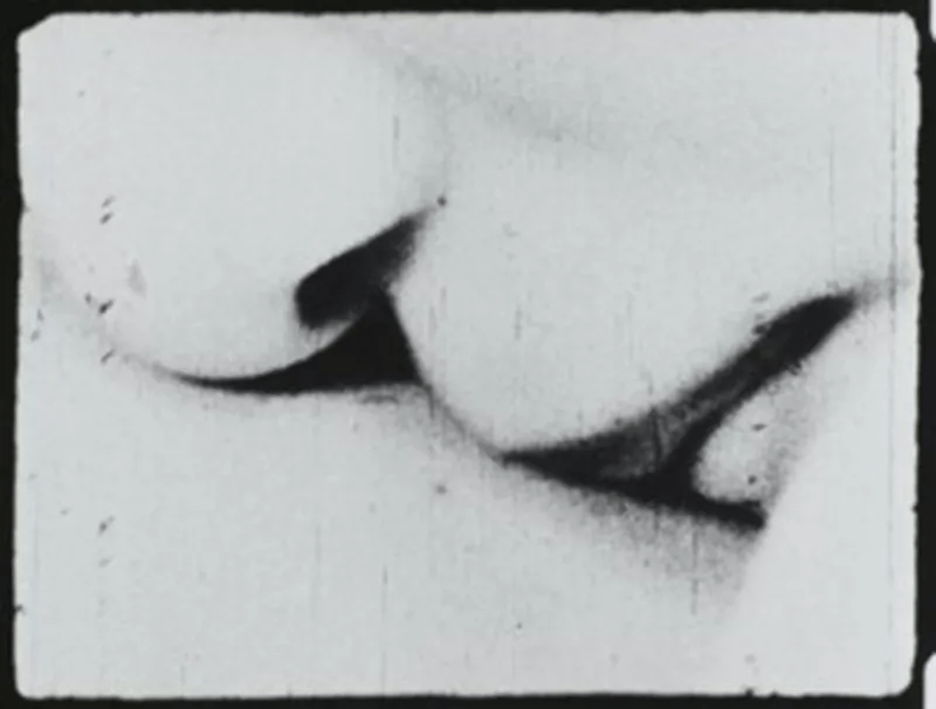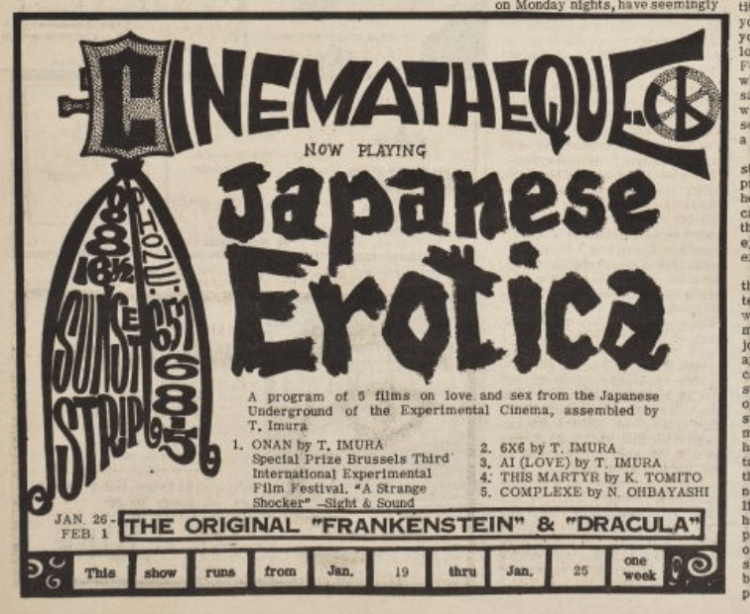
Guest post by Anthony Silvestri, member of the Underground Film Series programming team.
After taking fall semester off, on January 27th the Underground Film Series returns to IU Cinema. This is the first of two screenings that reaffirm our central mission: to program rarely shown, subversive works that communicate a unique vision of cinema. We view such screenings as important alternatives to the constraints of commercial filmmaking: the avant-garde can function as both a formal and ideological counterpoint to the films that generally populate multiplexes, reminding us that the possibilities of cinema as an art form extend beyond the transmission of narrative. This month, we open with the works of Japanese experimental filmmakers and multimedia artists Takahiko and Akiko Iimura. In many ways, the Iimuras’ oeuvres provide an ideal (re)entry point into the avant-garde: Taka and Ako’s works intersected with cutting-edge movements such as Fluxus and the New York Underground, and they collaborated with and documented iconic artists like Jonas Mekas, Stan Brakhage, Yayoi Kusama, and Yoko Ono.
Like so many of us, after graduating from university Taka Iimura had no idea what he wanted to do, with the exception that he didn’t want an everyday salaried job. Frustrated with an industry job at a company that produced promotional films, Taka bought a camera to make “poetic film.” Working in Japan, Taka was isolated from the works of contemporary North American and European experimental filmmakers and the thirties films that inspired them. Only able to get information about these artists in the form of foreign books and magazines, Taka had no recourse but to imagine these avant-garde productions until the mid-1960s. Iimura co-founded a group called the Japanese Film Independent, writing a manifesto that established members as alternatives to the ideological and financial constraints of other forms of studio and independent filmmaking. The JFI, it stated, was “the only place where we can ignore commercial and political conditioning. This is a cinema which is against 35mm feature film. This is a cinema where we have freedom, based on our own standards.”[1]

Taka’s description of his early works — represented in our program by Iro (Colors) and Ai (Love) — follows this statement of purpose, establishing the works as more than just formal experimentation: “These experiments were not for the sake of technique, but for finding new areas in film expression.”[2] Following his interest in ignoring popular political conditioning, the Dada-inspired Junk captures refuse, an exercise the filmmaker would later call an early rumination on environmental destruction. Accompanied by Group Ongaku musician Yasunao Tone, Iro (Colors) is a brilliant abstraction that tracks the metamorphosis of wax and paint in oil and water. While we will not replicate the fantastic original circumstances of its projection at IU Cinema — a multimedia event in which the work was projected onto fellow artist Jiro Takamatsu’s naked back at the Sogetsu Art Center — it remains crucial to view the film on 16mm to get a sense of the interaction between projection, light, color, and the transformation onscreen.
Like many avant-gardists, Iimura used film as a political tool to rebel against censorship and push on the ways sexuality could be expressed in the visual arts. In On Eye Rape, he pierced holes into the frames of an American sexual education film to protest Japanese censorship laws. Ai (Love) was filmed in extreme close-ups in order to evade strict laws about the representation of nudity and pubic hair in particular: writhing legs, eyes, hairs, tongues licking, and more populate the frame. Ultimately, the result of Taka’s pragmatism is an alternative way of posing cinematic sexuality: an obfuscation of the body in its totality that reminds us of the fragmentary nature of sensuality and the many ways in which pleasure is experienced and felt. Posed against Yoko Ono’s score, Ai (Love) becomes a unique refamiliarization with the uncanny eroticism of the body.

Accompanying Taka overseas, assisting with the production of his films, and a filmmaker in her own right was Akiko Iimura.[3] Serving as a bridge between these creators in our program is Taka and Ako, one of several double portraits the duo produced of each other (see also Double Portrait [1973-1987] and I Love You [1973-1987]). Though Akiko routinely appears onscreen in Taka’s circulated work, she remains frustratingly under-documented and under-screened. One of the functions of this program is to bring Akiko’s solo-authored work to Bloomington, giving residents the unique chance to view films whose details remain cryptic online. To my knowledge, these films are only available for theatrical exhibition. As such, this screening may represent one of the few, if only, chances filmgoers in Bloomington truly have to familiarize themselves with the work of Akiko. Both Late Lunch and Mon Petit Album share a resonance with the rest of this screening: an interest in film as poetry, and a concerted effort to pair visual and musical experimentation. For Akiko, this comes in the form of a score by Belgian composer Jacques Bakeart performed by Fluxus violinist Takehisa Kosugi.

Travelling through the United States in the mid-1960s, Taka and Ako became crucial representatives of the Japanese avant-garde. As Malcolm Le Grice once told Time Out London, “For many years, Japanese experimental film was Takahiko Iimura.”[4] Taka programmed series of Japanese erotic avant-garde films that not only included his own works, but also other filmmakers like Katsuhiro Tomita and Nobuhiko Obayashi (who would later go on to direct, amongst other things, the psychedelic horror film Hausu [1977]). These films would, of course, be played at major hubs such as Los Angeles and New York and on college campuses, an important site for the circulation of avant-garde works. As with screenings of other Underground films of the period, the content of Iimura’s films was sometimes enough to provoke an unruly atmosphere. The Winter 1967 edition of Film Comment recalls one particularly lively screening at Yale University in which an unruly mob, estimated at 1,000 people and excited by a sensationalist description of Ai (Love), nearly shut down the screening. Outside the cinema doors, the crowd chanted “open the doors” and “skin flick,” leaving the street littered with papers, bottles, and beer cans.[5] As the theater manager attempted to explained to the crowd, Iimura’s approach to eroticism was hardly in line with the students’ prurient expectations. While we likely will not see the same unruliness accompanying this screening, we can only hope that the Iimuras’ films (and the works of iconic avant-gardist Naomi Uman, screening this April) can continue to cultivate the same energetic response when it screens at IU Cinema as an alternative vision of the potentialities of cinema as an art form.
[1] As translated by Taka in Scott MacDonald, “An Interview with Taka Iimura,” Journal of the University Film Association vol 33, no 4 (Fall 1981): 21. While Taka has written at length about his work, MacDonald’s interview is perhaps one of the best starter points for those interested in how the filmmaker has spoken about his own work.
[2] The Collected Writings of Takahiko Iimura, 18
[3] An excellent piece on the Japanese Underground’s circulation in Europe, including historical context and an interview with Takahiko Iimura, is available on the Asia Art Archive in America website.
[4] https://film-makerscoop.com/programs/celebrating-takahiko-iimura
[5] Robert Steele, “Japanese Underground Film,” Film Comment vol 4, no 2/3 (1967): 74-79.
Taka and Ako: The Iimuras’ Cine-Poetics, a collection of the Iimuras’ works that includes Ai (Love), Late Lunch, and more, will be screened at IU Cinema on January 27 as part of the Underground Film Series.

Anthony Silvestri is a Ph.D. Candidate in the Media School at Indiana University and member of the Underground Film Series programming team. He is currently writing his dissertation about the archives amassed by avant-garde filmmaker Kenneth Anger at the Kinsey Institute, and his work on experimental film and sexuality has been published in the peer-reviewed journals Porn Studies and Journal of Film and Video.